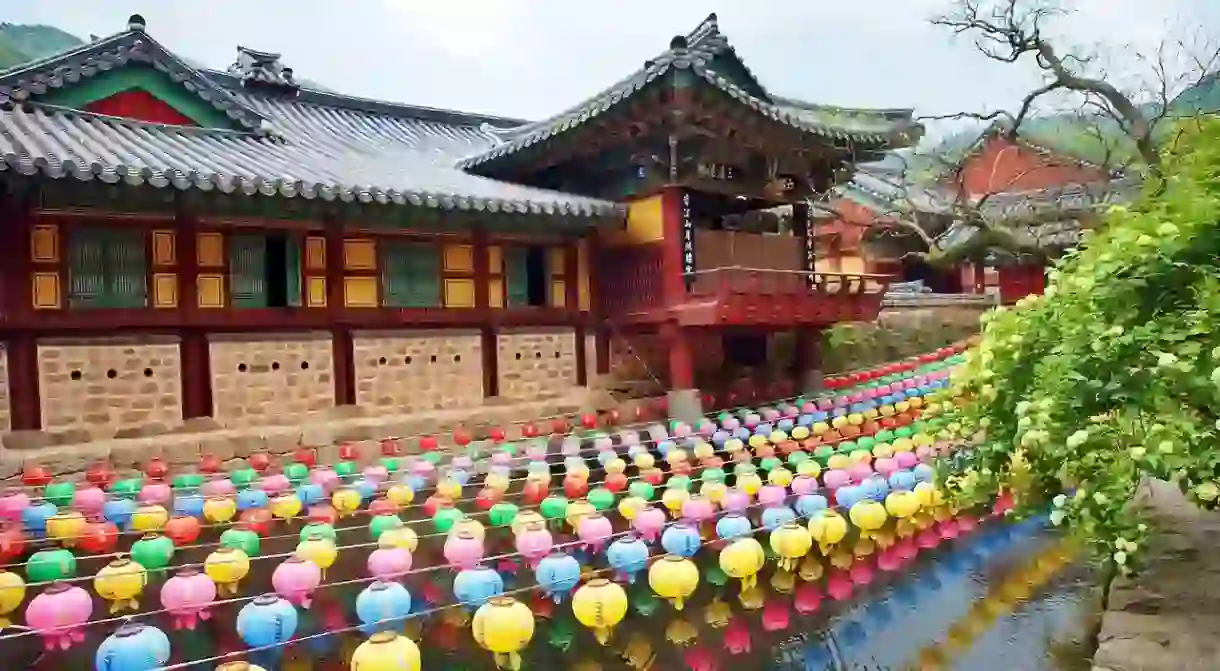Songgwangsa: Korea’s Third But Not Least Jewel Temple

Korea’s primary Buddhism jewel temple, Tongdosa, represents Buddha himself, and its second temple, Haeinsa, represents his teachings. Songgwangsa, the country’s third jewel temple, represents the seungga, or a community of Korean monks and nuns.
The Songgwangsa Temple has many special attractions and a location that allows visitors to hike around the Jogyesan Provincial Park in Jeollanam-do, the southwestern province where it is situated. There is also a tourist village at the trailhead leading to the temple, which can be reached by bus from either Suncheon on the south coast, or Gwangju, Jeollanam-do’s capital up until 2005, to the northwest.
Little is known of this temple’s early history, though, during the reign of the Unified Silla Dynasty, another temple called Gilsangsa existed on its original site and the mountain it was on was called Songgwangsan. In 1190, during the Goryeo Dynasty, a monk named Jinul who had started a large monastic community to the east called the Concentration and Wisdom Retreat Community, came to find larger facilities to house his followers. Jinul therefore founded the new and larger Suseonsa Temple on Gilsangsa’s property and renamed the mountain Jogyesan, which is still its name today. Later, Suseonsa was, in turn, renamed Songgwangsa, ironically adopting the mountain’s first name.

In his community, Jinul advocated a ‘sudden enlightenment, gradual cultivation’ approach based on enlightenment from studying the Flower Garland Sutra that slowly exfoliates through Seon (zen) practice. Jinul’s new temple was completed in 1205, and King Huijong, who held Jinul in high esteem, declared 120 days of celebration to mark the occasion and made him the National Preceptor. Jinjul died in 1210, while gripping his staff of office, and Songgwangsa has been a top temple ever since.
Songgwangsa’s claim to fame is that it’s the alma mater of numerous distinguished monks, including 15 other National Preceptors throughout the centuries. It continued its role as such into the 19th and 20th centuries, with the temple serving as a base for many patriarchs of meditational Buddhism. One of them was Master Gusan, who reconstructed the buildings in the 1970s after the damage they had sustained during the Korean War. He also established Korea’s first-ever International Seon Center, where the first non-Koreans to become Jogye Order monks (bigu) and nuns (biguni) received training. This led to missionary work resulting in many Korean Buddhist temples abroad, which attracted even more non-Korean converts. Countless ordinary Korean monks have also achieved enlightenment at Songgwangsa—today, being one of the temple’s monks is considered a high honor, as it means that the monk has followed in the footsteps of distinguished forebears.

Within its pine-scented grounds, Songgwangsa has a number of official national treasures, aside from its buildings of interest. Right at the entrance, for example, is the Four Heavenly Kings gate, which was built in 1628 and was therefore presumably part of the restorative construction after the temple was destroyed by the Japanese invasion of the 1590s. Near the gate is an enormous rice bowl from the early 18th century that was made for feeding visitors during national rituals. Other treasures include a small portable wooden triptych and a Tibetan book thought to have been donated by Kublai Khan, as well as an edict from the Goryeo Dynasty King Gojong proclaiming a monk named Hyegam as a National Preceptor.

Even if you cannot see all these treasures, Songgwangsa is still worth visiting just for the beauty of its buildings. The oldest of these is the Guksajeon which was built in 1369 but has been remodeled several times since then and contains original portraits of the 16 National Preceptors who came from Songgwangsa. The oldest dormitory for the monks is Hasadang, dating from 1461 and last remodeled in 1899. It can be recognized by a ventilation aperture on its roof that looks like a belvedere.
Even if you’re not an avid student of Korean Buddhism, the ride to the tourist village followed by an uphill walk through the forest to the temple is impressive. Songgwangsa can be visited as a day trip in between Suncheon and Gwangju and does not require an overnight stay. It is by far the most secluded of Korea’s three jewel temples, which adds to its calming atmosphere and gives those who visit a chance to experience a much-needed sense of serenity and peace.













